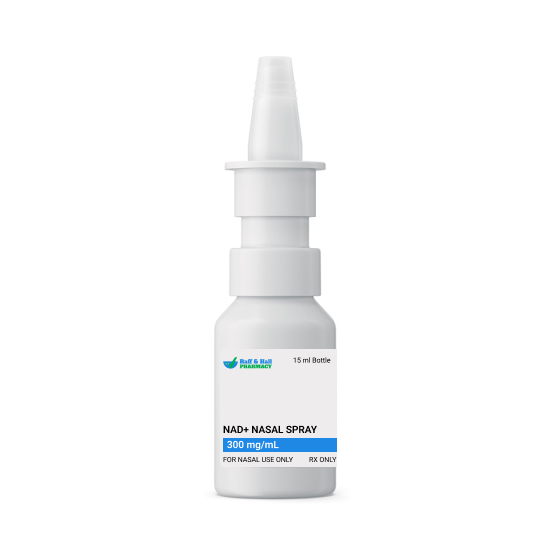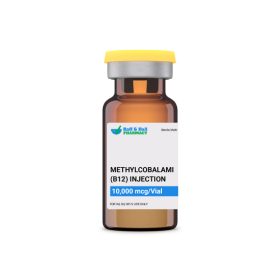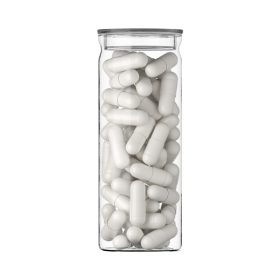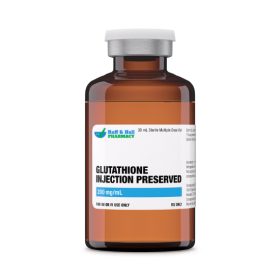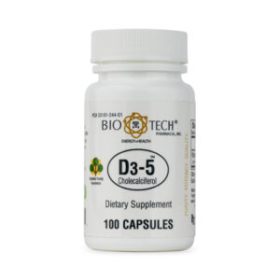This product is available solely through our 503A Compounding Pharmacy, ensuring personalized care and precision in every order. Please note that a valid prescription is required for purchase. If you do not have an account, please contact us.
NAD+ Nasal Spray (15 mL)
NAD⁺ Nasal Spray is a wellness product designed to deliver nicotinamide adenine dinucleotide (NAD⁺) directly through the nasal membranes for rapid absorption. NAD⁺ is a coenzyme involved in energy production and cellular repair processes. This spray is often marketed as a supportive therapy for improving mental clarity, reducing fatigue, and promoting overall metabolic health. While research is ongoing, some users incorporate it as part of a broader health and wellness routine under professional guidance.
NAD⁺ plays a critical role in cellular metabolism by assisting enzymes involved in energy generation, DNA repair, and regulation of oxidative stress. When absorbed through the nasal tissues, it is believed to enter the bloodstream more quickly than oral supplements, potentially enhancing bioavailability. Once in circulation, NAD⁺ helps facilitate reactions that convert nutrients into usable energy, support cellular resilience, and maintain neurological function. These combined effects may contribute to improved physical and cognitive performance.
NAD⁺ Nasal Spray should be avoided by individuals with known allergies to its ingredients or those with certain medical conditions such as autoimmune disorders, liver impairment, or uncontrolled chronic illnesses unless advised by a healthcare provider. Caution is advised for individuals taking medications that affect metabolism or neurological function. Users should consult a healthcare professional before beginning use, especially if they are pregnant, breastfeeding, or managing underlying health issues.
Some users may experience mild side effects such as nasal irritation, dryness, or a slight burning sensation after use. Others might feel lightheadedness or headaches, particularly when first using the spray. Allergic reactions like swelling, rash, or difficulty breathing are rare but possible. If any severe symptoms occur, the spray should be discontinued immediately and medical advice sought. Regular use should be monitored to avoid excessive dosing or dependency.
The safety of NAD⁺ Nasal Spray during pregnancy or breastfeeding has not been fully established. As a precaution, it is not recommended unless specifically directed by a healthcare provider. Potential effects on fetal development or breast milk composition remain uncertain. Women who are pregnant or nursing should explore safer alternatives and consult their doctor before using this supplement to ensure both their health and that of their child.
Store this medication in a refrigerator between 36°F to 46°F (2°C – 8°C). Do not freeze. Protect from light. Keep all medicine out of the reach of children. Throw away any medicine after the beyond use date. Do not flush unused medications or pour down a sink or drain.
- Cantó C, Menzies KJ, Auwerx J. NAD+ Metabolism and the Control of Energy Homeostasis: A Balancing Act between Mitochondria and the Nucleus. Cell Metab. 2015;22(1):31-53. doi:10.1016/j.cmet.2015.05.023
- Johnson S, Imai SI. NAD+ biosynthesis, aging, and disease. F1000Research. 2018;7. doi:10.12688/f1000research.12120.1
- Belenky P, Bogan KL, Brenner C. NAD+ metabolism in health and disease. Trends Biochem Sci. 2007;32(1):12-19. doi:10.1016/j.tibs.2006.11.006
- Guse AH. The Ca2+-Mobilizing Second Messenger Cyclic ADP-Ribose. In: Calcium: The Molecular Basis of Calcium Action in Biology and Medicine. Springer Netherlands; 2000:109-128. doi:10.1007/978-94-010-0688-0_7
- Billington RA, Travelli C, Ercolano E, et al. Characterization of NAD uptake in mammalian cells. J Biol Chem. 2008;283(10):6367-6374. doi:10.1074/jbc.M706204200
- Massudi H, Grant R, Braidy N, Guest J, Farnsworth B, Guillemin GJ. Age-Associated Changes In Oxidative Stress and NAD+ Metabolism In Human Tissue. Polymenis M, ed. PLoS One. 2012;7(7):e42357. doi:10.1371/journal.pone.0042357
- Camacho-Pereira J, Tarragó MG, Chini CCS, et al. CD38 Dictates Age-Related NAD Decline and Mitochondrial Dysfunction through an SIRT3-Dependent Mechanism. Cell Metab. 2016;23(6):1127-1139. doi:10.1016/j.cmet.2016.05.006
- Yoshino J, Mills KF, Yoon MJ, Imai SI. Nicotinamide mononucleotide, a key NAD + intermediate, treats the pathophysiology of diet- and age-induced diabetes in mice. Cell Metab. 2011;14(4):528-536. doi:10.1016/j.cmet.2011.08.014
- Goldberger J. Public Health Reports, June 26, 1914. The etiology of pellagra. The significance of certain epidemiological observations with respect thereto. Public Health Rep. 1975;90(4):373-375. https://www.ncbi.nlm.nih.gov/pmc/articles/PMC1437745/.– LinkOpens in New Tab Accessed October 11, 2020.
- Grant R, Berg J, Mestayer R, et al. A Pilot Study Investigating Changes in the Human Plasma and Urine NAD+ Metabolome During a 6 Hour Intravenous Infusion of NAD+. Front Aging Neurosci. 2019;11. doi:10.3389/fnagi.2019.00257
- Pillai JB, Isbatan A, Imai SI, Gupta MP. Poly(ADP-ribose) polymerase-1-dependent cardiac myocyte cell death during heart failure is mediated by NAD+ depletion and reduced Sir2α deacetylase activity. J Biol Chem. 2005;280(52):43121-43130. doi:10.1074/jbc.M506162200
- Wu J, Jin Z, Zheng H, Yan LJ. Sources and implications of NADH/NAD+ redox imbalance in diabetes and its complications. Diabetes, Metab Syndr Obes Targets Ther. 2016;9:145-153. doi:10.2147/DMSO.S106087
- Csiszar A, Tarantini S, Yabluchanskiy A, et al. Role of endothelial NAD+ deficiency in age-related vascular dysfunction. Am J Physiol – Hear Circ Physiol. 2019;316(6):H1253-H1266. doi:10.1152/ajpheart.00039.2019
- Ying W, Xiong Z-G. Oxidative Stress and NAD+ in Ischemic Brain Injury: Current Advances and Future Perspectives. Curr Med Chem. 2010;17(20):2152-2158. doi:10.2174/092986710791299911
- Zhu X, Su B, Wang X, Smith MA, Perry G. Causes of oxidative stress in Alzheimer disease. Cell Mol Life Sci. 2007;64(17):2202-2210. doi:10.1007/s00018-007-7218-4
- Abeti R, Duchen MR. Activation of PARP by oxidative stress induced by β-amyloid: Implications for Alzheimer’s disease. Neurochem Res. 2012;37(11):2589-2596. doi:10.1007/s11064-012-0895-x
- Lin JB, Apte RS. NAD + and sirtuins in retinal degenerative diseases: A look at future therapies. Prog Retin Eye Res. 2018;67:118-129. doi:10.1016/j.preteyeres.2018.06.002
- O’Hollaren P. Diphosphopyridine nucleotide in the prevention, diagnosis and treatment of drug addiction. West J Surg Obstet Gynecol. May 1961.
- Mestayer PN. Addiction: The Dark Night of the Soul/ Nad+: The Light of Hope – Paula Norris Mestayer – Google Books. Balboa Press; 2019. https://books.google.com/books?id=t7qEDwAAQBAJ&lr=&source=gbs_navlinks_s.– LinkOpens in New Tab Accessed October 11, 2020.
- Braidy N, Villalva MD, van Eeden S. Sobriety and satiety: Is NAD+ the answer? Antioxidants. 2020;9(5). doi:10.3390/antiox9050425
- Gerdts J, Brace EJ, Sasaki Y, DiAntonio A, Milbrandt J. SARM1 activation triggers axon degeneration locally via NAD+ destruction. Science (80- ). 2015;348(6233):453-457. doi:10.1126/science.1258366
- Essuman K, Summers DW, Sasaki Y, Mao X, DiAntonio A, Milbrandt J. The SARM1 Toll/Interleukin-1 Receptor Domain Possesses Intrinsic NAD+ Cleavage Activity that Promotes Pathological Axonal Degeneration. Neuron. 2017;93(6):1334-1343.e5. doi:10.1016/j.neuron.2017.02.022
- Oshima J, Sidorova JM, Jr. Monnat RJ. Werner syndrome: Clinical features, pathogenesis and potential therapeutic interventions. Ageing Res Rev. 2017;33:105-114.
- Fang EF, Hou Y, Lautrup S, et al. NAD+ augmentation restores mitophagy and limits accelerated aging in Werner syndrome. Nat Commun. 2019;10(1):1-18. doi:10.1038/s41467-019-13172-
- Yu CE, Oshima J, Fu YH, et al. Positional cloning of the Werner’s syndrome gene. Science (80- ). 1996;272(5259):258-262. doi:10.1126/science.272.5259.258

